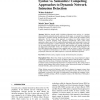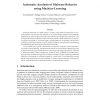19 search results - page 1 / 4 » A Quasi-Species Approach for Modeling the Dynamics of Polymo... |
INFOCOM
2006
IEEE
13 years 10 months ago
2006
IEEE
— Polymorphic worms can change their byte sequence as they replicate and propagate, thwarting the traditional signature analysis techniques used by many intrusion detection syste...
IJSN
2008
13 years 4 months ago
2008
: Malicious network traffic, including widespread worm activity, is a growing threat to Internet-connected networks and hosts. In this paper, we consider two competing approaches t...
BROADNETS
2007
IEEE
13 years 11 months ago
2007
IEEE
Abstract— Encounter-based network is a frequentlydisconnected wireless ad-hoc network requiring immediate neighbors to store and forward aggregated data for information dissemina...
JCS
2011
12 years 7 months ago
2011
Malicious software—so called malware—poses a major threat to the security of computer systems. The amount and diversity of its variants render classic security defenses ineffe...
INFOCOM
2003
IEEE
13 years 9 months ago
2003
IEEE
— It has been clear since 1988 that self-propagating code can quickly spread across a network by exploiting homogeneous security vulnerabilities. However, the last few years have...


